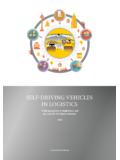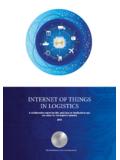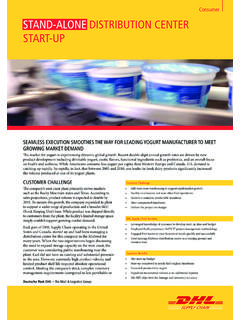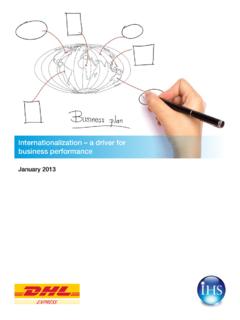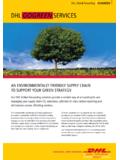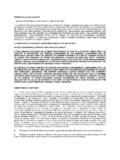Transcription of THE FUTURE OF LIFE SCIENCES AND HEALTHCARE …
1 THE FUTURE OF life SCIENCES AND HEALTHCARE LOGISTICSA DHL perspective on key trends and technologiesJune 2017 PREFACE .. 31 INTRODUCTION .. 42 DEEP DIVES ON KEY TRENDS .. 6 Advancing Data Analytics (Big Data) .. Increasing Visibility through Connectivity (Internet of Things) .. HEALTHCARE On-Demand (On-Demand Delivery) .. Automating for Speed and Accuracy (Robotics and Automation) .. Increasing Efficiency with Augmented Reality .. Leveraging Additive Manufacturing .. The FUTURE of life SCIENCES and HEALTHCARE logistics .. 163 CONCLUSION AND OUTLOOK .. 18 Table of Contents2 From 2015 to 2019, global HEALTHCARE spending is expected to increase by Along with growth, the sector is going through significant transformation of its operating models and supply chains.
2 These include three key developments:First, there are significant pressures from governments and regulatory authorities to lower costs, and deliver more affordable and quality HEALTHCARE . From patient diagnosis to final delivery of products, the industry will need to adopt new commercial and service models across all touch-points in the value chain to be cost-competitive. This is forcing businesses to rationalize their portfolios and re-evaluate how they should , consumer behavior has undergone rapid change. Consumers increasingly receive services through online channels and mobile applications, driving significant growth in areas such as tele-health and e-pharmacies. Better-informed patients also demand higher service , digitalization and related technology advancements are opening up new possibilities for life SCIENCES & health-care companies to enable different types of services and reduce developments represent opportunities and threats for the life SCIENCES & HEALTHCARE industry.
3 The industry is currently ranked in the bottom 20th percentile of the Industry Digitization Index2, even behind the public sector. Businesses which are able to reinvent themselves to meet the demands of the market will be the winners of tomorrow. There is a sense of urgency to transform now; and supply chains play a crucial role in this transformation. In this report, we seek to answer:1. Which trends and technologies can enable this transformation in the sector supply chains, and how?2. What are the concrete solutions and opportunities for action?This report serves as a guide to foster collaborative discussions and innovative projects with our customers and partners as we strive to be the provider of choice for delivering HEALTHCARE to the world. Enjoy the read!PREFACES cott Allison President life SCIENCES & HEALTHCARE DHL Customer Solutions & Innovation Preface31 2 Jane, a 40-year old working professional living in an urban city, has a lot to handle.
4 Apart from a full-time job, Jane is also raising two children and caring for elderly parents. Jane is at risk for diabetes due to family history and needs regular monitoring. She prefers to book her regular checks at a hospital that meets her desired level of service and price. She chose the hospital that offers booking appointments via a hospital app and virtual consultations, reducing her hospital receives a reminder one day before the appointment to test her blood sugar. Using a smart monitoring kit, Jane self-checks her blood sugar which updates the readings directly to the hospital. Her smart bracelet captures data on heart rate, blood pressure, sleep patterns, time of taking current medication, and other vital bracelet also transmits the readings to the doctor s monitoring on patient s data, the doctor recommends a 3-D printed medicine customized for her treatment and genetics.
5 By scanning her prescription via the hospital 1 INTRODUCTIONP icture the patient journey in the year 2027:Introduction4app, Jane orders her medicines to be delivered directly to her house. She also receives a reminder on her app to book a home care session for her elderly parents. With Jane s parents unable to leave the house, the professional HEALTHCARE provider visits the home to conduct a check-up. Knowing the patient s history, the provider also brings the specific test kits and medication required for them. All at the convenience and safety of Jane s home. Jane s experience outlines the HEALTHCARE trends of self-care, remote monitoring and virtually-connected platforms. While this scenario seems visionary, examples that exist today suggest we are not so far away. Re-designed for home care, the Medtronic Hemodialysis machine enables dialysis care from home.
6 Abbott s smartphone-enabled cardiac monitor enables remote engagement with doctors. Moving towards a patient-centric HEALTHCARE approach will require a transformation in sector supply chains. Supply chain managers must stay abreast with technologies and leverage them to support this 1: Evolving Patient NeedsHome Care SessionsSmart Monitoring KitsOnline orders for Medicines Home DeliveryPersonalized MedicinesVirtual ConsultationsIntroduction53 4 5 Internet of Things (IoT) devices for HEALTHCARE will grow 6 times to 646 million by IoT-enabled tagging technologies allow tighter control of product inventories across supply chains, reducing waste while increasing service levels and availabi-lity. Stronger links between physical products and data will also aid the industry in its ongoing battle against theft and counterfeiting.
7 To meet increasing complexity and service requirements without adding excessive costs, LSHC supply chains will turn to Robotics and Automation. Collaborative robots that work safely alongside humans and Autonomously Guided Vehicles (AGVs) can speed up simple operations. Unmanned Aerial Vehicles (UAVs) are available to serve remote areas and meet emergency delivery requirements. As treatments become increasingly personalized, new manufacturing technologies will enable medical devices and even drugs to be manufactured with Additive Manufacturing. It will enable the switch to on-demand and small batch manufacturing reducing inventories and making supply chains more agile and HEALTHCARE analytics market is set to grow by 24% by Advancing Data Analytics combined with real time view of operations will predict demand more accurately and optimize supply chains including storage, inventory, routing and risk planning.
8 Linking real-time view of demand to supply enables optimization across the whole value chain, from manufacturing to are building up HEALTHCARE On-Demand models in response to increasing online and home care channels. The online pharmaceutical markets will grow to $128 billion by This will require solutions for direct-to- consumer deliveries and e-commerce fulfillment strategies to increase speed and flexibility in last-mile. LSHC manufacturers will go further downstream into hospitals to enable on-demand delivery of devices from medical parts to surgery ways of displaying and presenting information will make LSHC supply chain operations more accurate and efficient. Augmented Reality enables increasing picking efficiency and reduces counterfeits in supply chains with latest advancements in visual cryptography.
9 2: Key trends and technologies transforming LSHC supply chainsDerived from the logistics Trend Radar, published by DHL, this report dives into six key trends and technologies that play the biggest role in transforming the life SCIENCES & HEALTHCARE (LSHC) supply chains. These are summarized Dives in Key Trends6 6 7 #4cdd06c0146f 8 9 10 2 DEEP DIVES ON KEY Advancing Data Analytics (Big Data)KEY DEVELOPMENTS & IMPLICATIONS Real time and more accurate view of operations allow LSHC providers to optimize resources with greater precision and reduce inventory costs and wastage. Four hospitals that make up the Assistance Publique- H pitaux de Paris are trialing platforms that predict admission rates based on past admission records to improve hospital bed management and The US-based Geisinger Health System s Unified Data Architecture, a Big Data platform, tracks and correlates supply chain data to clinical information from its electronic medical records by surgery type and provider.
10 Supplies ranging from the smallest of surgical sponges to thousand dollar medications or devices are tracked, along with waste in the operating rooms. This has led to new lean supply chain initiatives, with powerful insights on supply use patterns and inventory Linking real-time view of demand to supply enables optimization across the whole value chain, from manufacturing to consumption. Predictive analytics to identify demand spikes informs pharmaceutical manufacturers when to ramp up production, stocks and delivery resources ahead of time. Bayer AG uses big data from climate change and global weather trends to model hayfever occurrences in the US. With this data, production of its flagship anti-allergy drug, Claritin, is ramped up nine months ahead of a spike in Researchers at Harvard have used Google search data to predict influenza outbreaks based on the number of times people search for flu-related symptoms or treatments.
